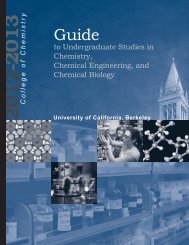Newsjournal body.qxp - College of Chemistry - University of ...
Newsjournal body.qxp - College of Chemistry - University of ...
Newsjournal body.qxp - College of Chemistry - University of ...
Create successful ePaper yourself
Turn your PDF publications into a flip-book with our unique Google optimized e-Paper software.
ments in nuclear science and nuclear astrophysics. Shortlived<br />
radioactive isotopes, such as carbon-11 with a<br />
20-minute half-life, are produced at the Biomedical<br />
Isotopes Cyclotron, rapidly transported as carbon dioxide<br />
gas through a 350-meter capillary to the 88-inch Cyclotron,<br />
injected into its main ion source and finally accelerated as<br />
an ion beam. BEARS also has the only oxygen-14 beam<br />
(half-life 71 seconds) in the world. This very proton-rich<br />
beam is particularly <strong>of</strong> interest for nuclear astrophysics<br />
experiments related to the relative abundances <strong>of</strong> the<br />
isotopes <strong>of</strong> the lighter elements.<br />
Entering a hot field<br />
Born in Alabama, Cerny received his B.S. in chemical<br />
engineering from the <strong>University</strong> <strong>of</strong> Mississippi in 1957.<br />
Following a year at the <strong>University</strong> <strong>of</strong> Manchester, England,<br />
as a Fulbright Scholar, he decided to focus on nuclear<br />
chemistry, and his undergraduate advisors encouraged<br />
him to attend Berkeley for his doctorate.<br />
“At that time nuclear chemistry was a hot field [no pun<br />
intended], and Berkeley was the place to be. Glenn Seaborg<br />
had recently arranged for a highly innovative new<br />
cyclotron [the 88”] to be built at LBNL, and new equipment<br />
was continually coming online.” He received his<br />
Ph.D. from Berkeley in 1961, using Lawrence’s last<br />
cyclotron on the Berkeley campus (located about where<br />
Pimentel Hall is now), and joined the faculty that same<br />
year.<br />
Administrative positions<br />
Cerny began his distinguished administrative career<br />
as chair <strong>of</strong> the chemistry department, serving from 1975 to<br />
1979. One <strong>of</strong> his more interesting experiences as chair was<br />
presiding over the first-ever review <strong>of</strong> chemistry by the<br />
Graduate Division. He was then chosen to help lead LBNL,<br />
serving as an Associate<br />
Director as well as the<br />
head <strong>of</strong> its Nuclear<br />
Science Division from<br />
1979 to 1984. He moved<br />
back down to the campus<br />
after a sabbatical to<br />
hold simultaneously the<br />
positions <strong>of</strong> Vice<br />
Chancellor for Research<br />
and Dean <strong>of</strong> the<br />
Graduate Division from<br />
1985 through 2000.<br />
Improving postdoc affairs<br />
As the Graduate Division Dean, Cerny became involved in<br />
postdoctoral affairs and has been instrumental in advancing<br />
the cause <strong>of</strong> postdocs at Berkeley, improving the<br />
stature and working conditions <strong>of</strong> these important but<br />
transient appointees. He helped to establish the Berkeley<br />
Postdoctoral Association and has worked at the national<br />
level to recommend standardizing the pay and treatment<br />
<strong>of</strong> postdocs. “At most universities, responsibility for postdoctoral<br />
fellows lies with either the vice chancellor for<br />
research or the graduate dean. In my opinion, leadership at<br />
this level is critical for substantial progress to be made in<br />
regularizing postdoctoral education. Since I held both <strong>of</strong><br />
these positions at Berkeley, it was very clear to me whose<br />
job it was,” Cerny has noted. Through his leadership, postdocs<br />
received improved recognition by the campus (the<br />
systemwide <strong>University</strong> has now created an academic personnel<br />
category for postdocs), obtained general access to<br />
health care coverage, and received more equitable<br />
compensation.<br />
. . . . . . . . . . . . . . .<br />
HOTBED OF<br />
RESEARCH.<br />
The capacity <strong>of</strong> LBNL<br />
to produce radioactive<br />
compounds for<br />
scientific study has<br />
increased through<br />
Cerny’s guidance.<br />
“At most universities, responsibility for postdoctoral fellows lies with either the vice chancellor<br />
for research or the graduate dean....Since I held both <strong>of</strong> these positions at Berkeley, it was very<br />
clear to me whose job it was.”<br />
. . . . . . . . . . . . . . . . . . . . . . . . . . . . . . . . . . . . . . . . . . . . . . . . . . . . . . . .NEWSJOURNAL 2005<br />
9




